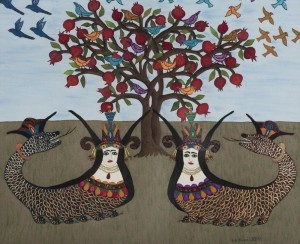
It is known in Central Asia Turks are improved themselves in textile arts and Seljuk Turks are following them. Since textile products are more vulnerable to aging, fewer samples of textile works survived to this date. It can be seen that the found textile samples are decorated with geometric motifs of the era. Textile arts in Anatolian Seljuk period continues with the famous silk weaves. In the textiles where the red color is predominantly seen, gold and silver are also used during weaving, while for decoration mainly bird figures animals are used.
Starting from the 15th century an increase can be seen in a variety of Turkish textiles. The tradition of hiding the clothes of the Ottoman sultans in labeled parcels helped to preserve samples and richness of weaving tradition.
Silk, velvet, seraser (woven with gold and silver wire), kemha (brocade), red efladi, çatma (a kind of velvet), speckle, taffeta textiles; which are often enriched by different processes, weaved with symmetrical geometric or floral motifs and without figures by the Ottomans. Both textiles and kaftans are exported from Bursa. It is known that Bursa exported both woven textiles and kaftan. From recordings of the gifts of the palace, it is understood that many different cities of the empire had textile production. Some of the examples of these textiles are Sereng-i Istanbul, Benek-i Bursa, Dibay-i-Sam, Atlas-i Sakız and Mukaddem-i Hasanpaşa.
In the 16th century, following a drop-in quality a code about textile standarts was issued. It specified some standard for fiber count, length, type and knitting count of the textiles. Textile production in the 17th century Istanbul was increased in both quality and quantity. Aleppo, Damascus, Menemen and Chios were also active production center in this period. Plank leaf, pomegranate, moon, peacock feather, rose, leaf were among the frequently used motifs. While atlas, diba, çaha started to be used in dresses, the production of gold and silver woven fabrics is reduced and simplification is seen in colors. With the 18th century, the rise of textile arts stopped and started to declines. In the second half of the 19th century, clothes from various fabrics were prepared and sent to Turkish pavilions on world exhibitions. In 1843, the silk factory in Hereke was opened and produced to meet the needs of the palace. Apart from clothes, special fabrics are also used in banners and tents.
Kırkyama which also called “kırkpare” and rag bag is a kind of patchwork often created by assembling and sewing up fabric pieces. Fabrics gathered together with kırkyama technique, which are found in early parts of the world in various regions, are recognized by their unique designs with the central composition like sun, star, flower over time. A variety of textile products or accessories such as clothes, bedspreads, quilts, mattresses, bed linens, blankets, pillowcases, hats, scarves, berets, bags.
Yazmacılık, which is a technique of fabric design applied by hand drawing or by printing with tree molds, has been carried on since the 14th century in Anatolia. After the 15th century, Tokat became the center of it. Decoration in two groups of monochrome and multicolored prints is done by pressing the tree molds into the fabric or by brushing the paint onto the fabric. Istanbul, Kandilli became prominent in this method among many places in Anatolia. In the fabric design, pencil work and mold techniques are used; the molds are made of metal or wood. Cotton fabrics that absorb the dye quickly and do not drain are preferred in for this technique.




